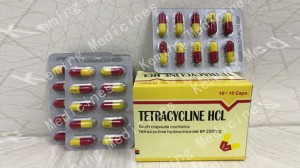Indications
1. Tetracycline Hydrochloride Capsules is used as the first choice or selected drug for the following diseases. (1) Rickettsial diseases, including epidemic typhus, endemic typhus, Rocky Mountain fever, scrub typhus and Q fever. (2) Mycoplasma infection. (3) Chlamydia infection, including psittacosis, venereal disease, lymphedema, non-specific urethritis, salpingitis, cervicitis and trachoma. (4) Relapsing fever. (5) Brucellosis. (6) Cholera. (7) Tularemia. (8) Plague. (9) Chancroid. It is used in combination with aminoglycosides for the treatment of brucellosis and plague. 2. Since common pathogenic bacteria are now seriously resistant to tetracyclines, only when the pathogenic bacteria are sensitive to this product, there is an indication to use this type of drug. This product is also not suitable for the treatment of hemolytic streptococcal infection and any type of staphylococcal infection. 3. This product can be used for patients with tetanus, gas gangrene, yaws, syphilis, gonorrhea and leptospirosis, as well as actinomycetes and Listeria monocytogenes infection who are allergic to penicillins.

Medicine Interactions
1. When used together with antacids such as sodium bicarbonate, as the pH value in the stomach increases, the absorption and activity of this product will be reduced, so antacids should not be taken within 1 to 3 hours after taking this product.
2. Drugs containing calcium, magnesium, iron and other metal ions can form insoluble complexes with this product, reducing the absorption of this product.
3. When combined with the general anesthetic methoxyflurane, its nephrotoxicity can be enhanced.
4. When combined with strong diuretics such as furosemide, it can aggravate renal function damage.
5. Liver damage can be aggravated when used in combination with other hepatotoxic drugs (such as antineoplastic chemotherapy drugs).
6. The hypolipidemic drugs colestyramine or colestipol can affect the absorption of this product and must be taken several hours apart.
7. This product can reduce the effect of contraceptives and increase the possibility of extramenstrual bleeding.
8. This product can inhibit the activity of plasma prothrombin, so patients receiving anticoagulant therapy need to adjust the dose of anticoagulant.
Pharmacokinetics
Tetracycline Hydrochloride Capsules can be absorbed orally but not completely, and about 60% to 70% of the administered dose can be absorbed from the gastrointestinal tract. Oral absorption is affected by food and metal ions, which form complexes with the drug to reduce absorption. After a single oral dose of 250 mg of this product, the peak plasma concentration (Cmax) is 2-4 mg/L. Multiple doses of 250 mg or 500 mg of the drug are taken orally (after taking the drug once every 6 hours), and the steady-state blood drug concentrations can reach 1-3 mg/L and 1.5-5 mg/L, respectively. After absorption, it is widely distributed in tissues and body fluids in the body, and is easy to penetrate into pleural effusion, ascites, and fetal circulation, but it is difficult to penetrate the blood-cerebrospinal fluid barrier. This product is easy to combine with bone and teeth and other tissues. The concentration in fetal circulation can reach 20% to 75% of the mother’s body. This product can be secreted into milk, and the concentration in milk can reach 60% to 80% of the maternal blood concentration. The protein binding rate is 55% to 70%. This product is mainly excreted from the body by glomerular filtration. The blood elimination half-life (t1/2β) of patients with normal renal function is 6 to 11 hours, and it can reach 57 to 108 hours in anuric patients. The unabsorbed part is excreted in the feces in its original form, and a small amount of the drug is excreted from the bile to the intestinal tract, so the renal function decline can significantly affect the clearance of the drug. This product can be slowly cleared from hemodialysis, about 10% to 15% of the administered dose can be cleared.
Post time: Feb-03-2023




